And another video in our revamped tutorial series: how you can manage your teams and privacy in Kerika.
https://youtu.be/k6-3f1Nlhh4
We hope these tutorials are useful; let us know what you think.
And another video in our revamped tutorial series: how you can manage your teams and privacy in Kerika.
https://youtu.be/k6-3f1Nlhh4
We hope these tutorials are useful; let us know what you think.
OK, another tutorial video done: this time on how to use Kerika with Box.
Kerika works seamlessly with Box for secure storage of all your project files: just sign up as a Kerika user with your Box ID, and all your Kerika files will be stored in your own Box Account, where they will always be under your control.
This tutorial video shows you how.
Intended audience for this video: new Kerika users who want to leverage Box.
One of our users had a problem recently when they mis-typed an email address while adding someone to a Board Team: the mistake was essentially a typo of “.com”
The user didn’t notice their error, but our system did: when Kerika tried to send the email invitation to the mis-typed address, the email bounced (naturally).
And while the user didn’t notice or complain, we want help our users avoid these mistakes by including some email checking when someone is being added to a Board Team.
Kerika now tries to see if the email address looks incomplete or malformed, and alerts you if you made a typo.
We have made it easier for Visitors to keep up with changes on the boards they are involved with, by extending our unique “heads-up” notification highlights to include Visitors. (Previously, this feature worked only for Team Members and Board Admins.)
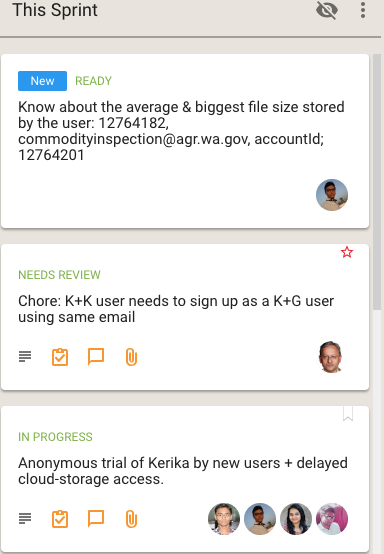
These heads-up notifications are customized for each Board Admin, Team Member and Visitor: they show you exactly what’s new or changed on every card on a Task Board or Scrum Board.
(The term “heads-up” comes from the helmets used by fighter pilots, who need to see critical data all the time, without having to turn their heads.)

Views are unique to Kerika: no other work management system provides such an easy way to see what matters, across all the boards you are working on.
These Views make it easy for organizations to really scale up their use of Kerika across multiple projects and many ongoing projects at the same time.
We have now added a very useful new View: What’s New and Updated. As you might guess from the name, this View lets you catch up on everything that’s new and changed, across all the boards you are working on — as a Board Admin, Team Member or Visitor.
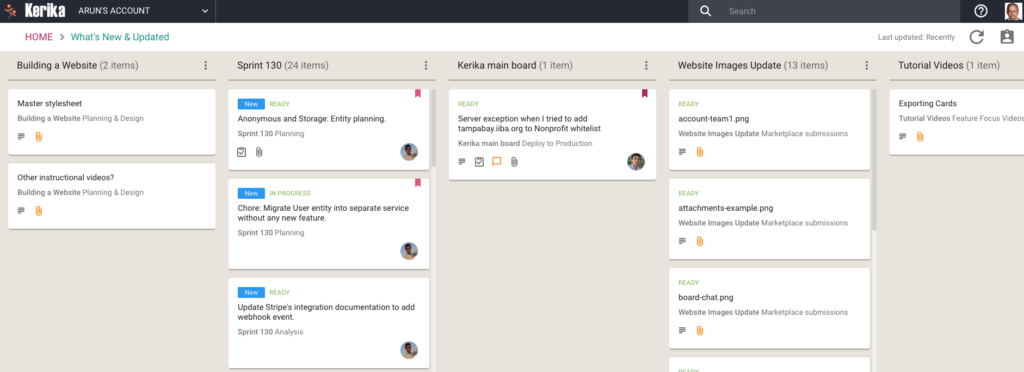
This View can work very effectively as a Dashboard for managers who need to keep track of many different boards, all working at the same time: instead of constantly revisiting each board one-by-one, this View is a simple, comprehensive way to see everything that’s changing across all your boards.
The updates are shown in Kerika’s unique “heads-up” notification style: the blue New tags highlight cards that have been newly added to your boards (that you haven’t opened yet), and the orange highlights show you precisely what’s changed on your old cards.
The new and changed cards are sorted into columns, with each column containing all the new and changed items within a particular board. The newest changes appear at the top of a column, and if a board has nothing new to report, the corresponding column is not shown (so your View doesn’t get cluttered up.)
(Cards that are moved to the Done or Trash columns on a board are not included in the View, to help avoid getting the View cluttered.)
As with all Views, it’s easy to operate on all the cards within a column, by selecting the Column Actions button that appears on the top of each column:
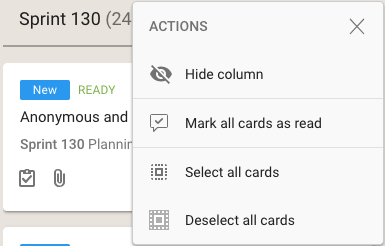
The Mark All Cards As Read action is useful if you want to ignore everything that’s going on in a particular board, e.g. when you have just returned from a status meeting where you got fully briefed on what’s happening on a particular board.
Another way to temporarily ignore individual boards is to Hide Column: this collapses the column from the View, and let’s you focus more intently on the handful of boards you care most about.
Selecting a card in this View lets you open the card within the View itself, or to open it on the board where the card actually sits:
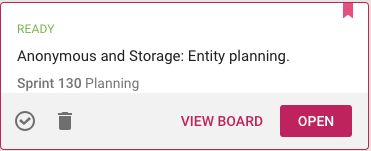
(Sometimes it’s easy to deal with cards just by themselves; sometimes the View Board action is more helpful, if you want to be sure you understand the full context in which a card changed.)
Using your mouse’s right-click action will also bring up a bunch of useful actions for that card:
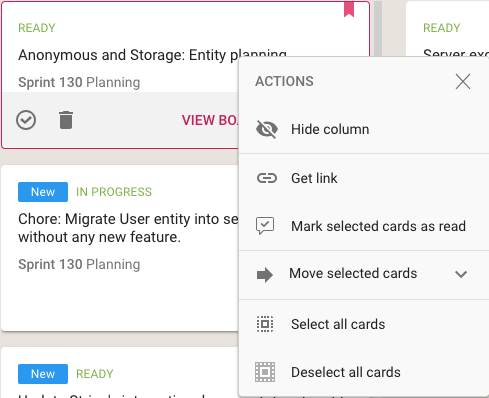
In addition to all the other actions you can perform on cards, you also have the option to get the URL (address) of card using the Get Link action. Every cards, every canvas and every board in Kerika has a unique address, and using these URLs anywhere on a board, e.g. in the board’s details or chat, will automatically set up a link between the two cards.
When you mark a card as “read” on this View, it remains on the View until you click on the Refresh button (shown at the top-right corner of the View).
And, as with all Views in Kerika, the What’s New and Updated View includes the “For Me” toggle button on the top-right corner: clicking this will quickly filter the View to show you just those items that are personally assigned to you.
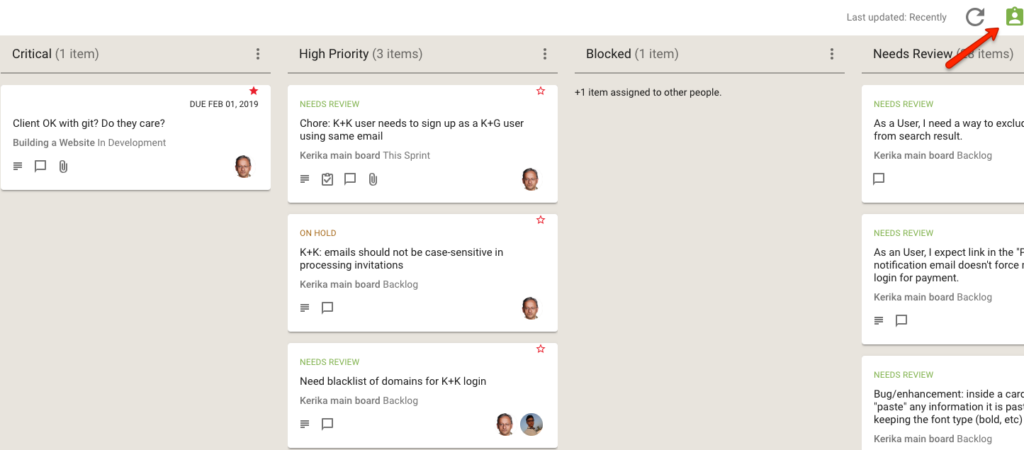
This feature is available to all our users, just like every other feature in Kerika: it doesn’t matter whether you are still in your 30-day free trial, you are working on the free Individual Plan, or are benefiting from Kerika’s free Academic and Nonprofits Accounts. Everyone always get the same Kerika goodies :-)
A new feature that should help our customers better manage their account teams, particularly in large organizations: the Account Owner can export (in Excel format) a complete list of everyone working on any boards owned by that account.
This feature can be found in the Manage Users tab of your Account page:

The exported data also includes the IP address last used by an account team member: this can help IT departments review their security periodically, or investigate any concerns they may have about misuse.
If you are using Kerika with Google, you don’t have to convert your documents to the Google Docs format in order to use Google Drive.
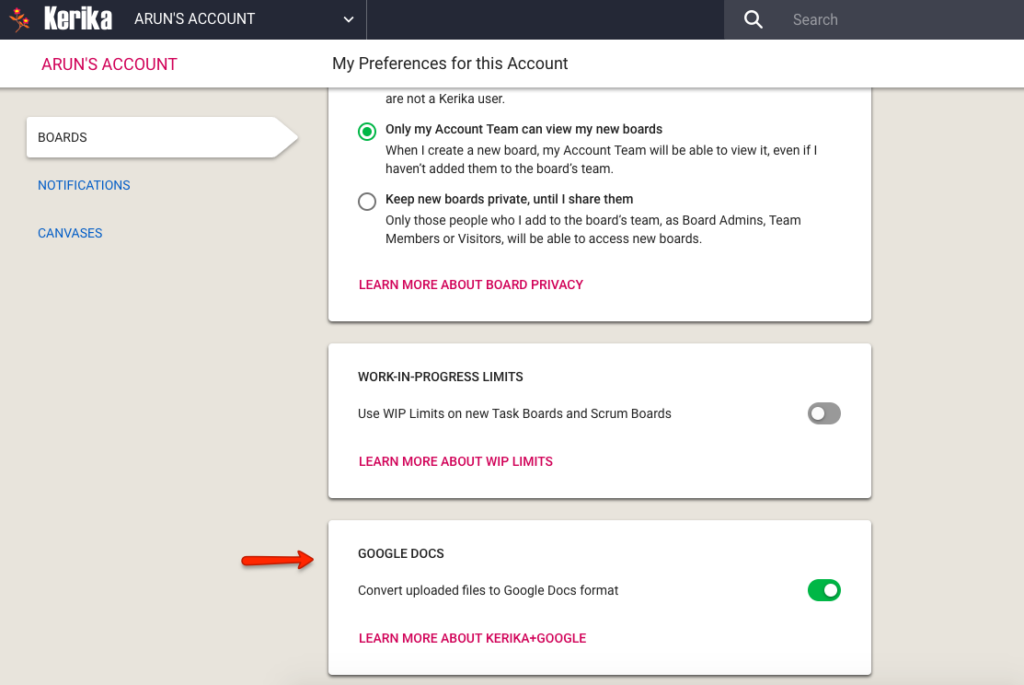
You can use this preference setting to ensure that your Microsoft Office documents, for example, are retained in MS Office format even while they they are stored and shared using Google Drive.
With the implementation of our shiny, new and fully automated billing system, it’s become a little more important for our customers to make sure that all the users within their organization are working in the right accounts — preferably, a single account.
Working in a single account, rather than a bunch of separate accounts, has advantages:
We have done a ton of improvements to the new user sign-up process to help guide people to working with their coworkers, using accounts that the coworkers have already set up, instead of creating new accounts.
But, there are still situations where an organization may find that, across all of its Kerika users, there are too many different accounts. If this is the case for you, we can help: we can consolidate multiple accounts into a single account if you ask us.
This consolidation preserves all the existing boards, content, and project teams: it just changes the ownership of everything to be a single user ID.
Let us know if we can help you with this.
The rollout of our new billing system seems to have been smooth — so far, fingers crossed! — and with this you now get better controls over who is part of your Account Team:
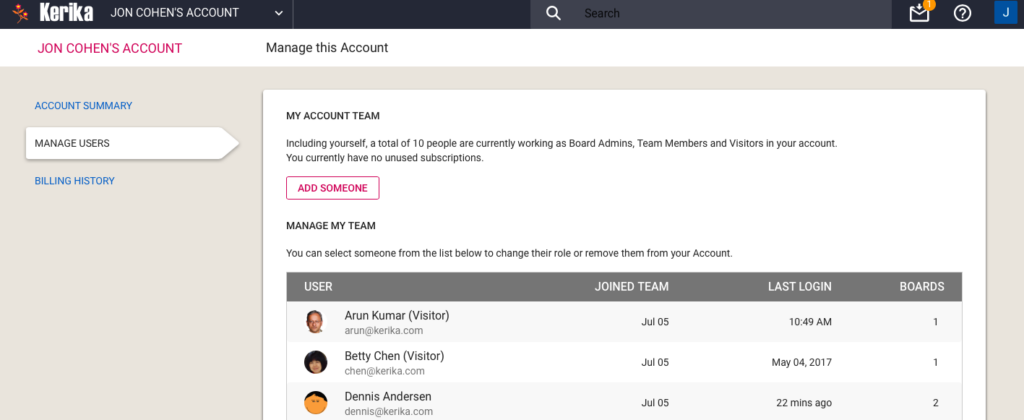
Please note that you don’t get charged for Visitors: if someone is only a Visitor on your boards — i.e. is not a Team Member or Board Admin on any board you own — you don’t need to pay for this person.
It doesn’t matter how many boards this person “visits”.
Visitors do show up on your Manage My Team list in the Manage Users tab, so you are reminded that they have access to some, possibly all, of your boards, and you can remove a Visitor entirely from your Account in the same way that you might remove a Team Member or Board Admin.